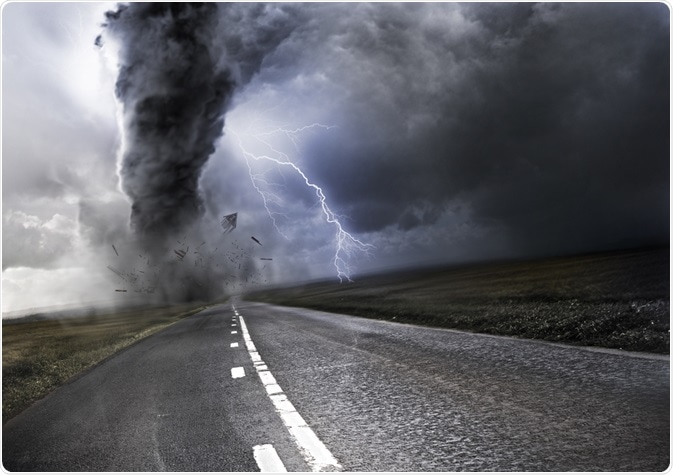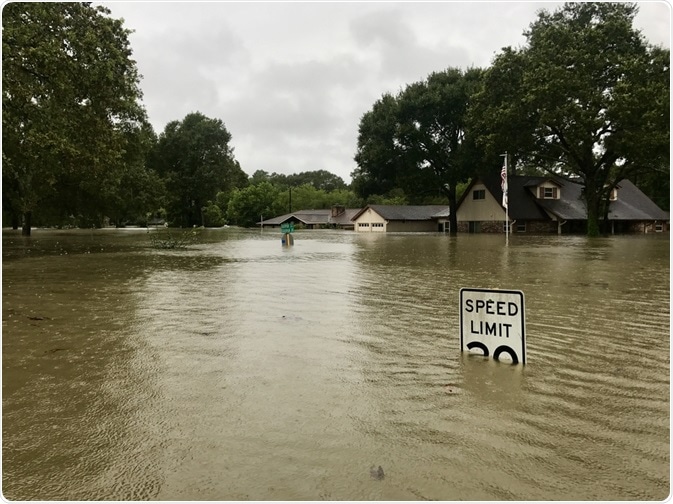Every year hundreds of natural disasters, from large to small scale, hit various areas of the globe. Disaster forensics looks at a better understanding of the fundamental causes of disasters, as well as the impacts they have on society.

Image Credit: solarseven/Shutterstock.com
Floods, earthquakes, and hurricanes are among the most commonly recurring disasters. Their impact can be devastating, not only in terms of loss of human life but also concerning economic and social repercussions.
In December 2004, the 9.1 earthquake outside the west coast of Sumatra – Indonesia – created a massive tsunami that caused almost 230,000 deaths, and displaced nearly two million people. Hurricane Katrina (New Orleans, August 2005) caused over 1,800 deaths and $125 billion in damage.
Floods are the most frequent type of disaster. Between 1998 and 2017 they affected more than two billion people, causing $656 billion in damages. More recently (July 2021), almost 200 people died during the floods in Germany and Belgium.
Introducing forensic disaster analysis
The Integrated Research on Disaster Risk (IRDR) and International Council for Science (ICS) have prompted the need for forensic disaster analysis, whose ultimate aim is to understand the fundamental causes of natural disasters and their impacts on society.
Despite being commonly addressed as “natural”, disasters originate from the combinations of both physical factors and socio-economic activities. The hazard itself is a natural phenomenon, however, the disaster is often the result of human activity and policy.
Different conceptual frameworks have been proposed to pursue a comprehensive analysis of disaster events. The term forensic in this case is not intended to identify blame or responsibility, but it is rather aimed at understanding how multiple factors contributed to disasters, to prevent and mitigate disaster risk for future events.
Forensic investigation of disasters – the FORIN framework
In 2010 the IRDR and ICS introduced the framework for Forensic Investigation of Disasters (FORIN) for the identification of root causes of disaster risk and a more efficient disaster risk management.
A forensic investigation may involve any one or combination of four basic approaches:
- Retrospective longitudinal analysis (RLA)
- FORIN disaster scenario building (FDSB)
- Comparative case analysis
- Meta-analysis
RLA consists of the temporal reconstruction of the processes that have produced disasters in the past. Starting from disaster damage and loss, RLA works backward, examining both the social and environmental processes and conditions that drive risk.
Based on both qualitative and quantitative methods and data, RLA provides a historical narrative of risk construction, identifying major patterns that are then traced to critical causal factors.
The FDSB approach creates scenarios to inform governments and communities of the risks specific to their social and physical environment, and how such risks will develop in the case of a disaster event. Scenarios are selected based on a known hazard that can realistically happen in the future.
Although the high uncertainty that disasters will occur as described, creating scenarios is important because encourages policymakers and decision-making bodies to consider a broader range of outcomes and responses.
Comparative case analysis focuses on a limited set of cases that show elements in common. The cases can be based on different places with similar event characteristics (geographically comparative), where the actions, decisions, and policies that led to a disaster risk are cross-examined.
Alternatively, the cases are based on two different events in time that happened in the same place (comparative in-situ). With this latter approach, it is possible to analyze which mitigation strategies worked (or did not work).
A meta-analysis, the fourth forensic approach in FORIN, is based on statistical methods and consists in reviewing the available literature on a specific topic, with the aim of identifying and assessing consistent findings across various studies.
This analytical approach offers potential for systematic investigation of disasters where the findings of the case studies are sufficiently comparable. However, for the methodology to be reliable, similar standards of quality of the studies included, and the data they provide must be ensured.
Other frameworks
FORIN is not the only conceptual framework. Depending on the circumstances, data availability, and time frame, other approaches for the forensic analysis of disasters have been developed.
One example is the near real-time forensic disaster analysis developed by the Center for Disaster Management and Risk Reduction Technology (CEDIM). The methodology can provide information within hours or days after the disaster event (hence the term “near real-time”).
The availability of databases that can be consulted is a critical condition. Platforms such as CATDAT (for earthquakes) or EQUATOR are among the sources often used. A near-real-time forensic disaster analysis was conducted on the Van earthquake (Turkey, October 2011) and provided an initial report in only 10 days from the event.
The Post-Event Review Capability (PERC) instead is generally conducted and published within a year of the disaster, encompassing all aspects of the disaster management cycle, from the management of disaster risk before the event, the disaster response, and the post-disaster recovery.
Although the primary focus of PERC is on floods, the methodology can be applied to other events. The study is conducted after the disaster response phase is over and during the recovery phase, in collaboration with local partners (i.e., government agencies, community leaders) that have an understanding of the local context and the necessary connections needed to collect useful, reliable, and accurate information.

Image Credit: MDay Photography/Shutterstock.com
Bridging the gap between disciplines
Understanding the root causes of disasters requires an interdisciplinary approach. Forensic investigations such as FORIN must interrogate the natural and physical sciences related to the natural hazards in place, such as atmospheric sciences for storms and floods, or geophysical sciences for landslides and earthquakes.
At the same time, since another goal of forensic disaster analysis is to be policy-relevant and to provide options for improved disaster risk reduction, other fields of expertise such as governance and communications must be necessarily involved.
One of the major challenges faced so far is interconnecting the natural and social sciences and efforts must therefore be focused on creating bridges among them.
Sources:
- Burton, I. (2015). The forensic investigation of root causes and the post-2015 framework for disaster risk reduction. International Journal of Disaster Risk Reduction, 12, 1-2. 10.1016/j.ijdrr.2014.08.006
- Oliver-Smith, A., Alcántara-Ayala, I., Burton, I. & Lavell, A. M. 2016. Forensic Investigations of Disasters (FORIN): a conceptual framework and guide to research (IRDR FORIN Publication No.2) Integrated Research on Disaster Risk. Beijing.
- Girard, T., Wenzel, F., Khazai, B., Kunz-Plapp, T., Daniell, J. E. & Brink, S. A. (2014). Near-Real-Time Analysis of Publicly Communicated Disaster Response Information. International Journal of Disaster Risk Science, 5, 165-175. 10.1007/s13753-014-0024-3
- Keating, A., Venkateswaran, K., Szoenyi, M., Macclune, K. & Mechler, R. (2016). From event analysis to global lessons: disaster forensics for building resilience. Natural Hazards and Earth System Sciences, 16, 1603-1616. 10.5194/nhess-16-1603-2016
Further Reading
Last Updated: Nov 12, 2021